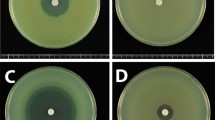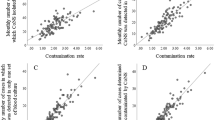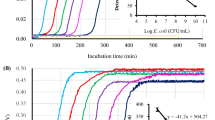Abstract
DURING investigations into the gain or loss of penicillinase in cultures of staphylococci1 there was a need for a simple method of screening these so as to be able to detect small numbers of penicillinase positive or negative organisms in mixed cultures. In addition, in the study of hospital cross-infection a quick reliable method was required for investigating many different strains of staphylococci for penicillinase production. A number of chemical and microbiological methods for detecting the ability of organisms to destroy penicillin have been described2–7. However, none of the methods in common use is really adapted for the study of mixed penicillinase-positive and negative populations on the surface of solid media, nor is it easy to use them so as to detect a few colonies of one type in the presence of a predominant growth of the other. One of the most useful diagnostic methods for pour plates is that described by Manson, Pollock and Tridgell8. We have modified their method by pouring agar containing penicillin and Andrade's indicator gently over colonies growing on the surface of agar plates, but under these conditions the method is not so sensitive nor so reliable as when deep cultures are used.
This is a preview of subscription content, access via your institution
Access options
Subscribe to this journal
Receive 51 print issues and online access
$199.00 per year
only $3.90 per issue
Buy this article
- Purchase on Springer Link
- Instant access to full article PDF
Prices may be subject to local taxes which are calculated during checkout
Similar content being viewed by others
References
Knox, R., Brit. Med. J., ii, 690 (1960).
Abraham, E. P., and Chain, E., Nature, 146, 837 (1940).
Harper, G. J., Lancet, ii, 569 (1943).
Gots, J. S., Science, 102, 309 (1945).
Henry, R. J., and Housewright, R. D., J. Biol. Chem., 167, 559 (1947).
Boxer, G. E., and Everett, P. M., Anal. Chem., 21, 670 (1949).
Penau, H., Philippe, J., and Benoist, D., Ann. Pharm. Franc., 9, 419 (1951).
Manson, E. E. D., Pollock, M. R., and Tridgell, E. J., J. Gen. Microbiol., 11, 493 (1954).
Lederberg, J., and Lederberg, E. M., J. Bact., 63, 399 (1952).
Robinson, G. N., Stevens, S., Batchelor, R. F., Cameron-Wood, J., and Chain, E. B., Lancet, ii, 564 (1960).
Author information
Authors and Affiliations
Rights and permissions
About this article
Cite this article
KNOX, R., SMITH, J. Use of Cellulose Acetate Membranes for detecting Penicillinase-producing Organisms. Nature 191, 926–927 (1961). https://doi.org/10.1038/191926a0
Issue Date:
DOI: https://doi.org/10.1038/191926a0
This article is cited by
-
An inducible β-lactamase in a strain ofEscherichia coli
Antonie van Leeuwenhoek (1975)
-
Cellular Location of the Genes Controlling Penicillinase Production and Resistance to Streptomycin and Tetracycline in a Strain of Staphylococcus aureus
Nature (1966)
-
Relative Instability of Cephaloridine to Staphylococcal Penicillinase
Nature (1965)
-
A Rapid Procedure for Screening Unusual Penicillin-resistant Clinical Strains of Staphylococci
Nature (1964)
-
Differences between Pencillinases from Gram-Positive and Gram-Negative Bacteria
Nature (1963)
Comments
By submitting a comment you agree to abide by our Terms and Community Guidelines. If you find something abusive or that does not comply with our terms or guidelines please flag it as inappropriate.



